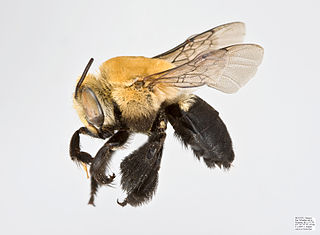
The genus Centris contains circa 250 species of large apid bees occurring in the Neotropical and Nearctic realms, from Kansas to Argentina. Most females of these bees possess adaptations for carrying floral oils rather than pollen or nectar. They mainly visit plants of the family Malpighiaceae to collect oil, but also visit others such as Plantaginaceae, Calceolariaceae, and Krameriaceae. Recent studies have shown they are sister to the corbiculate bees, the most well-known and economically important group of bees
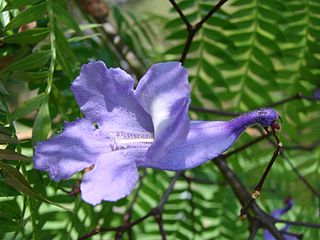
Jacaranda is a genus of 49 species of flowering plants in the family Bignoniaceae, native to tropical and subtropical regions of the Americas while cultivated around the world. The generic name is also used as the common name.

Calliandra is a genus of flowering plants in the pea family, Fabaceae, in the mimosoid clade of the subfamily Caesalpinioideae. It contains about 140 species that are native to tropical and subtropical regions of the Americas.

Persoonia, commonly known as geebungs or snottygobbles, is a genus of about one hundred species of flowering plants in the family Proteaceae. Plants in the genus Persoonia are shrubs or small trees usually with smooth bark, simple leaves and usually yellow flowers arranged along a raceme, each flower with a leaf or scale leaf at the base. The fruit is a drupe.

Krameria is the only genus in the Krameriaceae family, of which any of the approximately 18 species are commonly known as rhatany, ratany or rattany. Rhatany is also the name given to krameria root, a botanical remedy consisting of the dried root of para rhatany or Peruvian rhatany.

Senna, the sennas, is a large genus of flowering plants in the legume family. This diverse genus is native throughout the tropics, with a small number of species in temperate regions. The number of species is estimated to be from about 260 to 350. The type species for the genus is Senna alexandrina. About 50 species of Senna are known in cultivation.

Iresine is a genus of flowering plants in the family Amaranthaceae. It contains 20 to 25 species, all of which are native to the American tropics. The generic name is derived from the Greek word εριος (erios), meaning "wooly", referring to the trichome-covered flowers. Bloodleaf is a common name for those species that have colored foliage, and these are often cultivated as ornamental plants. Some species are additives to versions of the hallucinogenic drink ayahuasca.

Cleome is a genus of flowering plants in the family Cleomaceae, commonly known as spider flowers, spider plants, spider weeds, or bee plants. Previously, it had been placed in the family Capparaceae, until DNA studies found the Cleomaceae genera to be more closely related to the Brassicaceae than the Capparaceae. Cleome and clammyweed can sometimes be confused.

Copaifera is a genus of tropical plants in the legume family Fabaceae. It includes 40 species native to the tropical Americas, west and central tropical Africa, and Borneo.
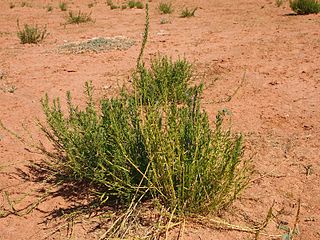
Stemodia is a genus of flowering plants in the family Plantaginaceae. The genus comprises approximately 45 species of annual and perennial herbs and shrubs which are distributed through tropical and temperate regions of the Americas, sub-Saharan Africa, the Indian subcontinent, and Australia. This genus is sometimes placed in the families Scrophulariaceae or Gratiolaceae. The generic name is derived from the Latin word stemodiacra, which means "stamens with two tips." Twintip is a common name for several species.

Maranta is a genus of flowering plants in the family Marantaceae, native to tropical Central and South America and the West Indies. Maranta was named for Bartolomeo Maranta, an Italian physician and botanist of the sixteenth century.

Diascia is a genus of around 70 species of herbaceous annual and perennial flowering plants of the family Scrophulariaceae, native to southern Africa, including South Africa, Lesotho and neighbouring areas.

Maurandya is a genus of flowering plants in the family Plantaginaceae, native to Mexico and the south west United States. They sprawl or climb by means of twining leaf stalks. One of the four species, Maurandya barclayana, is widely cultivated as an ornamental plant.
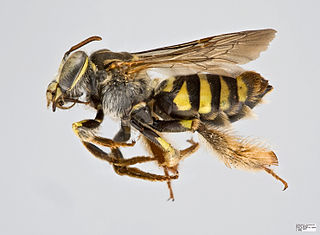
The 'Tapinotaspidini' are a tribe of apid bees. They belong to the order Hymenoptera and the family Apidae. The Tapinotaspidini tribe consists of 180 different species. Many species of Apidae are recognised as oil-collecting bees and Tapinotaspidini possess this oil-collecting behaviour. It is maintained that mutualism exists between oil secreting flowers and oil collecting Tapinotaspidini bees. Morphological and molecular phylogenies have found that the trait of oil-collecting is polyphyletic. Tapinotaspidini are solitary bees which collect oil sources from flowers belonging to the families of Malpighiaceae, Solanaceae, Orchidaceae, Calceolariaceae, Iridaceae, Plantaginaceae, Melastomataceae and Krameriaceae. Tapinotaspidini species differ in terms of being generalist and specialist oil-collectors. Selected species exclusively obtain floral oil from one family of flowering plants, whilst many Tapinotaspidini species employ a range of plant families to fulfil their oil-collecting behaviour.

Amasonia is a genus of plants in the family Lamiaceae, native to South America and to the island of Trinidad.
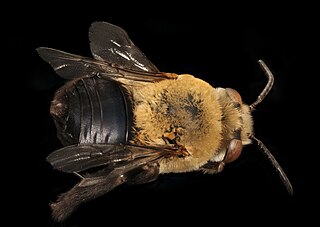
Centris atripes is a species of centridine bee in the family Apidae. It is found in Central America and North America. It is a pollinator of Krameria erecta as well as Senna wislizeni of the painteri variety, which it pollinates during the rainy season.
Unonopsis guatterioides, also known as envieira, is a species of the genus Unonopsis. It is a tree native to tropical Southern America which produces white flowers, and is known to be used in both construction, and tropical medicine


















